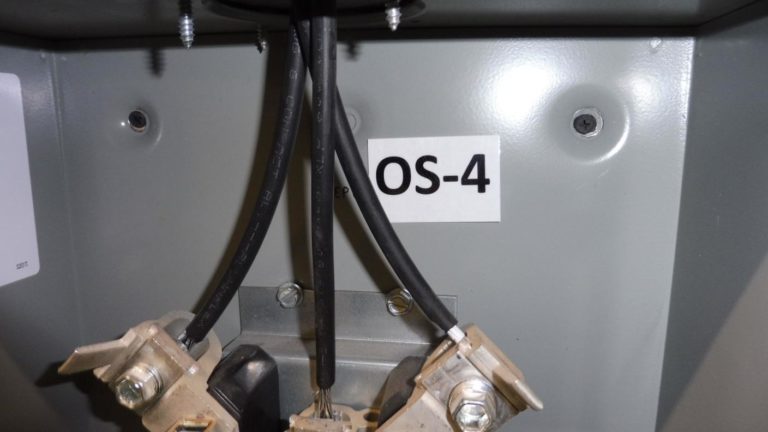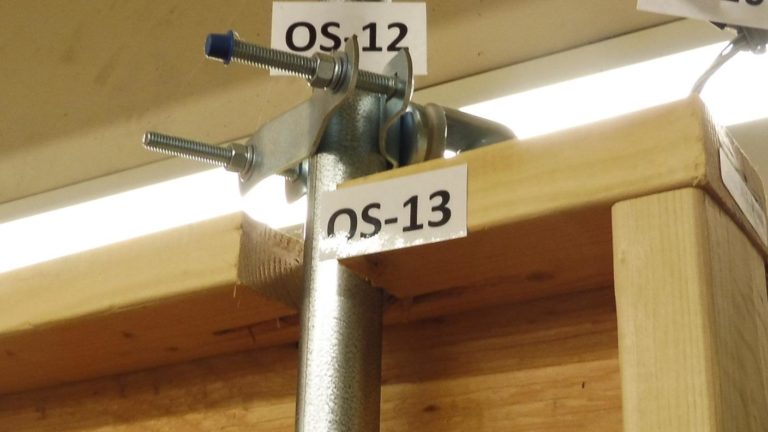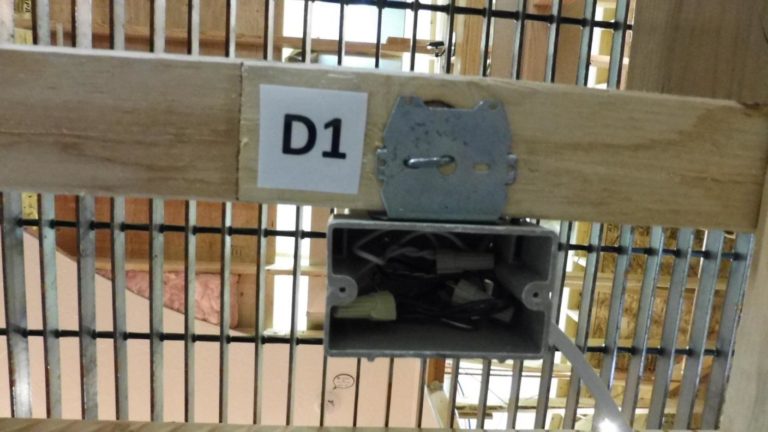STANDARDS OF PRACTICE
The International Standards of Practice for inspecting the roof system is located at www.nachi.org/sop.
FUSE BOXES
How Fuses Work
There are many different types of fuses for residential and commercial use, but the most common type is made up of a metal wire or filament that is enclosed in a glass or ceramic and metal casing. In a home, the fuse is typically plugged into a central fuse box where all the building’s wiring passes through. When the electricity is flowing normally, the fuse permits the power to pass unobstructed across its filament, between circuits. If an overload occurs, the filament melts, stopping the flow of electricity. It generally takes very little time for the filament in the type of fuse used in a home to melt, so any power surge is quickly stopped. Once a fuse is blown, however, it must be discarded and replaced with a new one. There are many different voltage and ratings available that handle different capacities of electricity, and the best fuse for a circuit is typically one that is rated for slightly higher than the normal operating current.
Observation

Display of an older Fuse box used between the 1920’s and the 1950’s. (Recommend updating when observed on an inspection).
Observation

Display of an older Fuse box used between the 1920’s and the 1950’s. (Recommend updating when observed on an inspection).
Observation

Display of an older Fuse box used between the 1920’s and the 1950’s. (Recommend updating when observed on an inspection).
Observation

Display of an older Fuse box used between the 1920’s and the 1950’s. (Recommend updating when observed on an inspection).
Observation

Display of an older Fuse box used between the 1920’s and the 1950’s. (Recommend updating when observed on an inspection).
Observation

Display of an older Fuse box used between the 1920’s and the 1950’s. (Recommend updating when observed on an inspection).
ELECTRICAL ROOM CEILING
Observation

This type of light fixture is only acceptable in temporary installations. Light did not come on when the wall switch was operated. Wire feeding the light box is draped over (touching)a plumbing pipe.
Observation

NM cable entering the electrical box is not secured. Nonmetallic-sheathed cable shall be supported and secured by staples, cable ties, straps, hangars, or similar fittings designed and installed so as not to damage the cable, at intervals not exceeding 1.4m (4 1/2 ft) and within 300mm (12in.) of every outlet box, junction box, cabinet, or fitting.
LAUNDRY/MECHANICAL ROOM DOOR WALL
Observation

Missing branch circuit feeder and device cover. (4 prong 30 Amp receptacle) with neutral wire (newer style).
Observation

Missing branch circuit feeder and device cover. (3 prong 30 Amp receptacle) no neutral wire (older style).
Observation

NM cable entering the electrical box is not secured. Nonmetallic-sheathed cable shall be supported and secured by staples, cable ties, straps, hangars, or similar fittings designed and installed so as not to damage the cable, at intervals not exceeding 1.4m (4 1/2 ft) and within 300mm (12in.) of every outlet box, junction box, cabinet, or fitting.
Article 210.12(A) Arc-Fault Circuit-Interrupter Protection, Dwelling Units. In the 2014 NEC, AFCI protection is now required in all kitchen areas and laundry areas. This is a significant change, and kitchens will now become somewhat of a “puzzle” since both GFCI and AFCI protection is required. If I were to wire a kitchen according to the 2014 NEC, I would probably accomplish this via a GFCI-protected subpanel (specifically dedicated to the kitchen), and use AFCI circuit breakers to feed the kitchen. On a side note, it is my understanding that there are electrical products being developed that will have both the required AFCI and GFCI protection built-in to the same breaker or device.
Observation

GFCI receptacle has no power.
Observation

Receptacle box should not be mounted on furnace duct work. Receptacle circuit wire missing approved connector. NM cable entering the electrical box is not secured. Nonmetallic-sheathed cable shall be supported and secured by staples, cable ties, straps, hangars, or similar fittings designed and installed so as not to damage the cable, at intervals not exceeding 1.4m (4 1/2 ft) and within 300mm (12in.) of every outlet box, junction box, cabinet, or fitting.
LAUNDRY/MECHANICAL ROOM DEFECT LIST
Observation

Missing correct wire connectors. Wire should be installed in metal flex, conduit or moisture resistant flex (depending on environment). Cable shall be supported and secured by staples, cable ties, straps, hangars, or similar fittings designed and installed so as not to damage the cable, at intervals not exceeding 1.4m (4 1/2 ft) and within 300mm (12in.) of every outlet box, junction box, cabinet, or fitting.
Observation

Missing wire connector.
Observation

Unsecured wire located next to the flue pipe. NM type cable shall not be located next to a heating system flue pipe.
Observation

Branch circuit cable for furnace is not connected to any source. Branch circuit cable is unsecured. Nonmetallic-sheathed cable shall be supported and secured by staples, cable ties, straps, hangars, or similar fittings designed and installed so as not to damage the cable, at intervals not exceeding 1.4m (4 1/2 ft) and within 300mm (12in.) of every outlet box, junction box, cabinet, or fitting.
Observation

Wire should be installed in metal flex or conduit when exposed to potential physical damage.
Observation

NM cable is not properly secured. Nonmetallic-sheathed cable shall be supported and secured by staples, cable ties, straps, hangars, or similar fittings designed and installed so as not to damage the cable, at intervals not exceeding 1.4m (4 1/2 ft) and within 300mm (12in.) of every outlet box, junction box, cabinet, or fitting.
Observation

NM type wire should be protected when potential physical damage is present. (NM cable is not approved for surface installation without protection). NM cable is not secured correctly. Nonmetallic-sheathed cable shall be supported and secured by staples, cable ties, straps, hangars, or similar fittings designed and installed so as not to damage the cable, at intervals not exceeding 1.4m (4 1/2 ft) and within 300mm (12in.) of every outlet box, junction box, cabinet, or fitting.
Observation

NM cable should be in a separate bored hole inside of the wall with a minimum 1 ¼” of space from both edges of the wood stud.
KITCHEN WALL (NEAR SINK)
Observation

GFCI Receptacle missing device cover.
Observation

Receptacle is not GFCI protected. Receptacle is missing device cover.
Article 210.12(A) Arc-Fault Circuit-Interrupter Protection, Dwelling Units. In the 2014 NEC, AFCI protection is now required in all kitchen areas and laundry areas. This is a significant change, and kitchens will now become somewhat of a “puzzle” since both GFCI and AFCI protection is required. If I were to wire a kitchen according to the 2014 NEC, I would probably accomplish this via a GFCI-protected subpanel (specifically dedicated to the kitchen), and use AFCI circuit breakers to feed the kitchen. On a side note, it is my understanding that there are electrical products being developed that will have both the required AFCI and GFCI protection built-in to the same breaker or device.
Observation

Receptacle is not GFCI protected. Receptacle is missing device cover.
Article 210.12(A) Arc-Fault Circuit-Interrupter Protection, Dwelling Units. In the 2014 NEC, AFCI protection is now required in all kitchen areas and laundry areas. This is a significant change, and kitchens will now become somewhat of a “puzzle” since both GFCI and AFCI protection is required. If I were to wire a kitchen according to the 2014 NEC, I would probably accomplish this via a GFCI-protected subpanel (specifically dedicated to the kitchen), and use AFCI circuit breakers to feed the kitchen. On a side note, it is my understanding that there are electrical products being developed that will have both the required AFCI and GFCI protection built-in to the same breaker or device.
Observation

Missing power connection.
Observation

No power supply to the dishwasher.
Article 210.8(D) Kitchen Dishwasher Branch Circuit – GFCI. GFCI protection must now be provided for outlets that supply dishwashers installed in dwelling unit locations. The GFCI protection must be provided whether or not the dishwasher is hardwired or receives power via cord and plug. Again, it is important to point out that a GFCI receptacle cannot be placed behind the dishwasher. This would require a person to move the appliance in order to reset the device. This would be a VIOLATION, since the receptacle has not met the definition of readily accessible. A possible solution to this dilemma would be to use a blank-face GFCI device, and to place that device in a readily accessible location (somewhere in the kitchen would probably be most convenient although that is not required).
KITCHEN
Observation

Fixture is not secured to the electrical box.
Observation

Disposal is missing wire connector. Disposal has an unapproved splice (silicon caulking being used for wire connection).
Observation

Electrical extension cord is wrapped around the plumbing drain line.
Observation

Un-grounded lamp cord being used to power the disposal.
ATTIC SPACE
Observation

Electrical connections are exposed and Junction box is missing blank cover. NM cable is not secured. Nonmetallic-sheathed cable shall be supported and secured by staples, cable ties, straps, hangars, or similar fittings designed and installed so as not to damage the cable, at intervals not exceeding 1.4m (4 1/2 ft) and within 300mm (12in.) of every outlet box, junction box, cabinet, or fitting.
Observation

NM cable is not correctly secured. Nonmetallic-sheathed cable shall be supported and secured by staples, cable ties, straps, hangars, or similar fittings designed and installed so as not to damage the cable, at intervals not exceeding 1.4m (4 1/2 ft) and within 300mm (12in.) of every outlet box, junction box, cabinet, or fitting.
OVERHEAD SERVICE
Observation

EMT conduit being used for the service riser (correct conduit would be threaded GRC (Galvanized Rigid Conduit).
Observation

EMT set screw coupling is not rated for outdoor use or for this application.
Observation

Compression conduit connector with rubber seal is not approved for this application (seal breaks the grounding continuity of the Riser Conduit).
Observation

Overhead feeders are undersized and not rated for the Main breaker amperage rating of 125 Amps. Main feeder wires missing Anti /Oxidant paste.
Observation

Threaded offset nipple is missing bonding bushing.
Bonding at Services
NEC Section 250.92(B) is applicable to (Bonding at services), and in part states, “Bonding jumpers and Bonding Bushings meeting the other Requirements of this article [Article 250] shall be used around concentric or eccentric knockouts that are punched or otherwise formed so as to impair the electrical connection to ground.” For services, this confirms that (bonding jumpers) are required unless all concentric or eccentric knockouts have been removed.
Observation

Threaded offset nipple missing Nylon Bushing (Prevents sharp edges from damaging conductors).
Observation

Threaded offset nipple missing bonding (ground wire) jumper.
Bonding at Services
NEC Section 250.92(B) is applicable to (Bonding at services), and in part states, “Bonding jumpers meeting the other
Requirements of this article [Article 250] shall be used around concentric or eccentric knockouts that are punched or otherwise formed so as to impair the electrical connection to ground.” For services, this confirms that (bonding jumpers) are required unless all concentric or eccentric knockouts have been removed.
Observation

Service Meter mounted at a low height that could be considered to be too low to service safely.
Observation

Service Entrance Cap is missing face cover for conductor entry point.
Observation

Neutral Conductor connector is not approved for this application. (acceptable connections would be a compression type or a split bolt).
Observation

Service conductors do not have the required drip loop.
What Purpose Does the Drip loop serve?
The reason for having a drip loop on an electrical service is to allow any rain or moisture that may make contact with the wires a place to go away from the weather head and the electrical connection to the utility company's wires. Water or moisture running down the service pipe or running into electrical connection points would spell costly repairs for you in the future. Its purpose is to channel the water away from any connections, boxes, or equipment. By diverting the water to a safe location, say half way between the power poles, it can safely drop to the ground without damaging anything. This drip point is accomplished by hanging the wire lower at some point and it becomes the last place the water travels before falling off of the wire or dripping.
Observation

Service riser does not meet the minimum clearance above the roof line (18”).
Observation

Service riser is missing roof flashing.
Observation

Wedge support is not carrying the weight of the service conductors.
A/C CONDENSING UNIT
Observation

A/C Unit has no power source.
Observation

A/C Unit is missing weathertight flex and fittings (required for protection of branch circuit wiring).
Observation

A/C Unit is missing the branch circuit disconnect.
FIREPLACE WALL
Observation

These electrical boxes are in the rough in stages of finish. (Recommendations)
- Test to verify that they are not energized.
- Note the status in the report.
- Recommend blank box covers for safety.
Observation

These electrical boxes are in the rough in stages of finish. (Recommendations)
- Test to verify that they are not energized.
- Note the status in the report.
- Recommend blank box covers for safety.
- NM Cable entering electrical boxes are not secure
- Nonmetallic-sheathed cable shall be supported and secured by staples, cable ties, straps, hangars, or similar fittings designed and installed so as not to damage the cable, at intervals not exceeding 1.4m (4 1/2 ft) and within 300mm (12in.) of every outlet box, junction box, cabinet, or fitting.
CRAWLSPACE
Observation

Junction box missing blank cover.
Observation

Exposed energized conductors at the cord cap. NM cable is not approved for use as an extension cord.
Observation

NM Cable is not secure. Nonmetallic-sheathed cable shall be supported and secured by staples, cable ties, straps, hangars, or similar fittings designed and installed so as not to damage the cable, at intervals not exceeding 1.4m (4 1/2 ft) and within 300mm (12in.) of every outlet box, junction box, cabinet, or fitting.
Observation

Furnace is missing branch circuit power. Furnace is missing isolation shutoff switch (SSU switch) or a Single pole switch.

